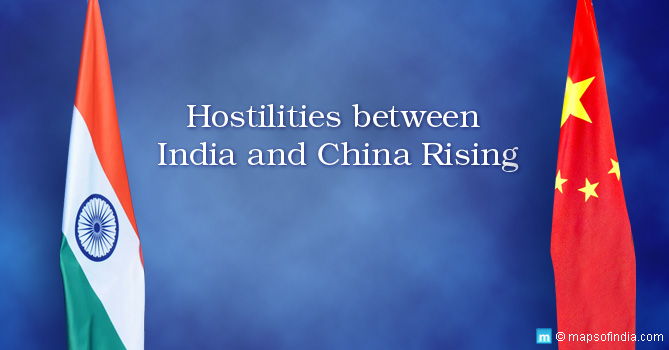In 2014, soon after the NDA government came to power at the centre, PM Narendra Modi and his cabinet made it amply clear that they will bring India to the spotlight and the country would take on an active role in global politics and trade. An important part of the agenda was improving diplomatic and friendly ties with all its neighbours, including Pakistan and China. Ever since the debacle of the 1962 war, India and China have retained a bitter legacy of mistrust and rivalry that successive governments have only managed to fester but not mitigate.
In September 2014, Chinese President Xi Jinping visited India. In May 2015, PM Modi reciprocated the gesture and went on a historic friendly visit to the PRC; it seemed quite likely that both nations were on the verge of a breakthrough. The two nations signed some 24 agreements including critical ones involving setting up of additional diplomatic missions and strengthening trade cooperation, while also agreeing to establish a military hotline to aid cooperation in the border areas.
Escalating Concerns
The government’s hopes of mending historic tensions, however, seem to have come to nought. Not only has China stood its stand and persistently blocked India’s efforts to garner support for a permanent membership at the UN Security Council, it has also blocked India’s efforts to list Masood Azhar on the United Nations list of ‘banned’ terrorists.
Jaish-e-Mohammed (JeM) and its leader Azhar were responsible for the terror attack on Pathankot Air Force base in January 2016. China used its Veto power at the UN Security Council and said that the JeM’s involvement was sketchy. Meanwhile, the government of India promised to take the issue up at the highest level with the Chinese. There were also talks of reinstating China as a “country of concern”; China had been pulled off the list in the light of improved relations. Another major move that China undertook, much to the ire of Indians, was to block India’s attempts to be included in the Nuclear Suppliers Group (NSG) while supporting Pakistan’s inclusion. China holds that India should not be included since the nation has desisted from signing the Nuclear Non-Proliferation Treaty (NPT).
Border Intrusions In Uttarakhand, Arunachal Pradesh
Adding fuel to the deteriorating relations and burgeoning concerns, China’s incursions into Indian soil have increased over the past few weeks. According to recent news reports, Harish Rawat, the Chief Minister of Uttarakhand, confirmed that a Chinese helicopter was involved in an incursion in the Chamoli district of Uttarakhand on 19 July, 2016. The helicopter entered Indian aerospace and hovered over our soil for about five minutes before returning to the PRC, according to a report sent to the government by the Indo-Tibetan Border Police (ITBP). CM Rawat is reported to have said, “The information is true and the situation is worrisome. Our border area has been peaceful so far and since the beginning we have demanded to increase vigilance.”
Worrisome as it is, the incursion comes within weeks of another transgression by the People’s Liberation Army (PLA – Chinese army) in the Yangtse region (East Kameng district) of Arunachal Pradesh. On 9 June, 2016, some 250 Chinese soldiers entered Indian soil and spent about three hours here before returning. China, however, rejected any allegation of such an incursion and claimed that the Indo-China border was not a clearly demarcated one. It also said that PLA troops were conducting “normal patrols” on the Chinese side of the LAC (Line of Actual Control).
Last month, a PLA fighter plane entered the Indian airspace in the he Aksai Chin area and flew over 107 minutes. Then, the JH7 flew back to China.
India Fortifies China Border
India, meanwhile, has lately been in the process of strengthening its border with China by deploying troops and tanks. Earlier this month, the Indian army deployed about 100 T-72 tanks to counter the aggressive build up of Chinese troops in Ladakh. This is only the second time in history that India has deployed tanks along the frontline in Ladakh. The last time this region saw tanks was when India and China were engaged in combat and 5 tanks were air dropped in a ditch attempt to stop the advancing Chinese army.
The army’s move to deploy tanks was undoubtedly a response to the massive infrastructural development and reconstruction across the Indo-Sino border. This aggressive militarization has caused much concern to India and also to global organizations. A report by the US Deputy Assistant Secretary of Defense read, “We have noticed an increase in capability and force posture by the Chinese military in areas close to the border with India.”
The deployment of additional troops and tanks, though, does not seem to have gone down well with China. Chinese officials threatened to withdraw crucial investment from India if the trend continued.
To protect India’s airspace, the government has, over the past few years been involved in the development of seven Advanced Landing Grounds (ALGs) in Arunachal Pradesh. Of these, the ones at Ziro and Along were inaugurated in March this year and three more are soon to be inaugurated.
The Route Through Negotiations
It is in the best interests of both India and China, and in fact the entire continent, for the nations to resolve the decades old border dispute through peaceful negotiations. Despite having held some 19 rounds of talks to resolve boundary issues, the nations have not been able to reach an understanding.
The failure to have a clearly demarcated international boundary with China is a colonial legacy passed down to India by the British. In 1914, the British signed the Simla Accord with Tibet recognizing the McMahon Line as a clear demarcation between the two regions (India and Tibet) but this is not recognized by the Chinese government. China also claims the Aksai Chin region as its own territory.
The resolution to this complex dispute is only possible if both nations make a concrete commitment to amicable dialogue and pledge not to carry on the legacy of discord and mistrust.





